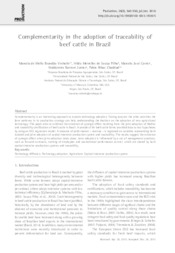Complementarity in the adoption of traceability of beef cattle in Brazil.
Complementarity in the adoption of traceability of beef cattle in Brazil.
Author(s): VINHOLIS, M. de M. B.; SOUZA FILHO, H. M. de; CARRER, M. J.; BARIONI JUNIOR, W.; CHADDAD, F. R.
Summary: Complementarity is an interesting approach to explain technology adoption. Taking account the other activities the farm performs in its production strategy can help understanding the decision on the adoption of new agricultural technology. This paper aims to evidence the existence of synergic effect resulting from the joint adoption of feedlot and traceability certification of beef cattle in Brazil. A sample of 84 beef cattle farms provided data to test hypotheses by using an OLS regression model. A measure of performance ? revenue ? is regressed on variables representing both isolated and joint adoption of capital-intensive production system and traceability. The results suggest the existence of synergic effect when joint adoption takes place. Joint adoption is influenced by a set of management practices, such as forward contracts, training of employees and zootechnical performance control, which are shared by both capital-intensive production systems and traceability.
Publication year: 2016
Types of publication: Journal article
Keywords: Technology adoption, Technology diffusion, agriculture
Observation
Some of Embrapa's publications are published as ePub files. To read them, use or download one of the following free software options to your computer or mobile device. Android: Google Play Books; IOS: iBooks; Windows and Linux: Calibre.
Access other publications
Access the Agricultural Research Database (BDPA) to consult Embrapa's full library collection and records.
Visit Embrapa Bookstore to purchase books and other publications sold by Embrapa.

